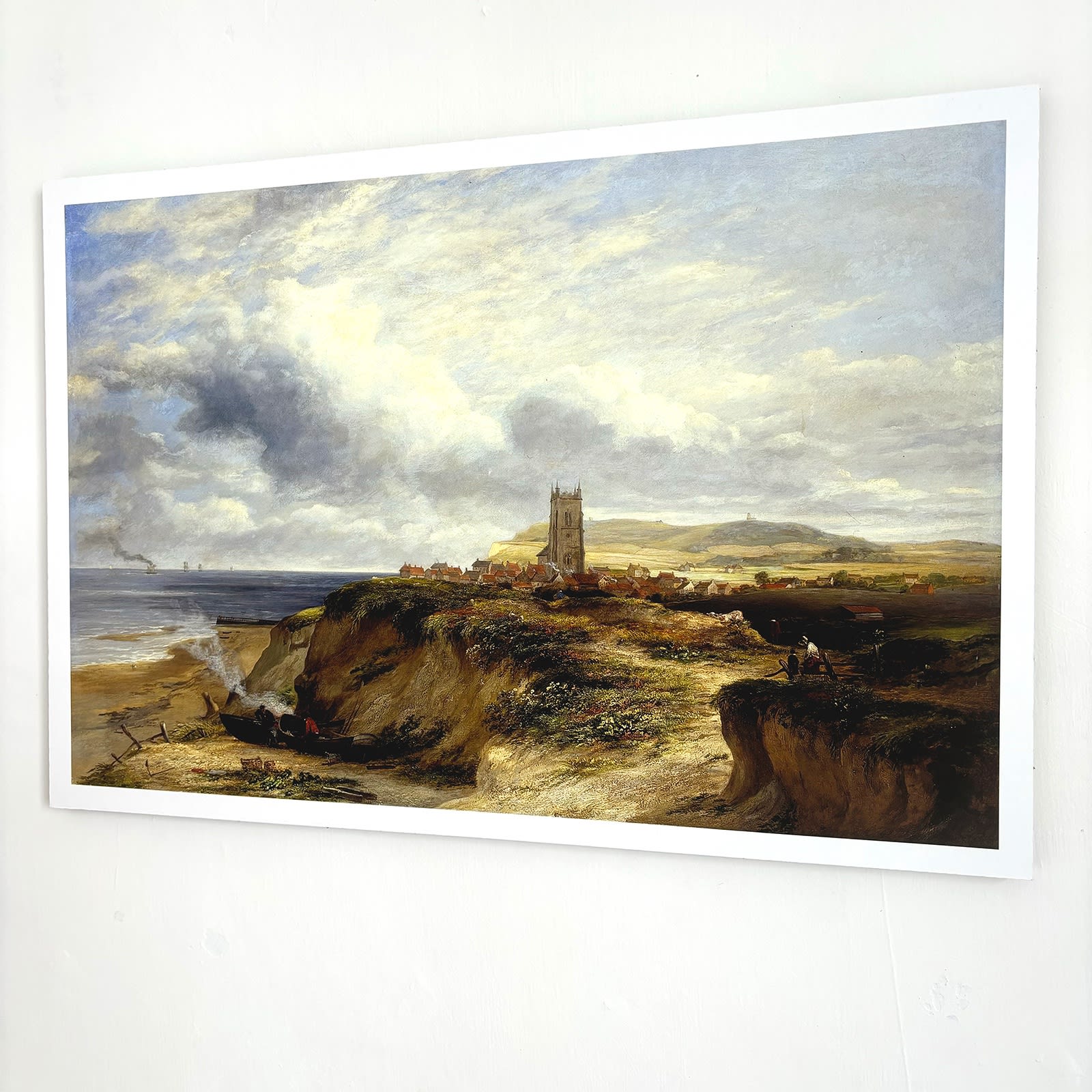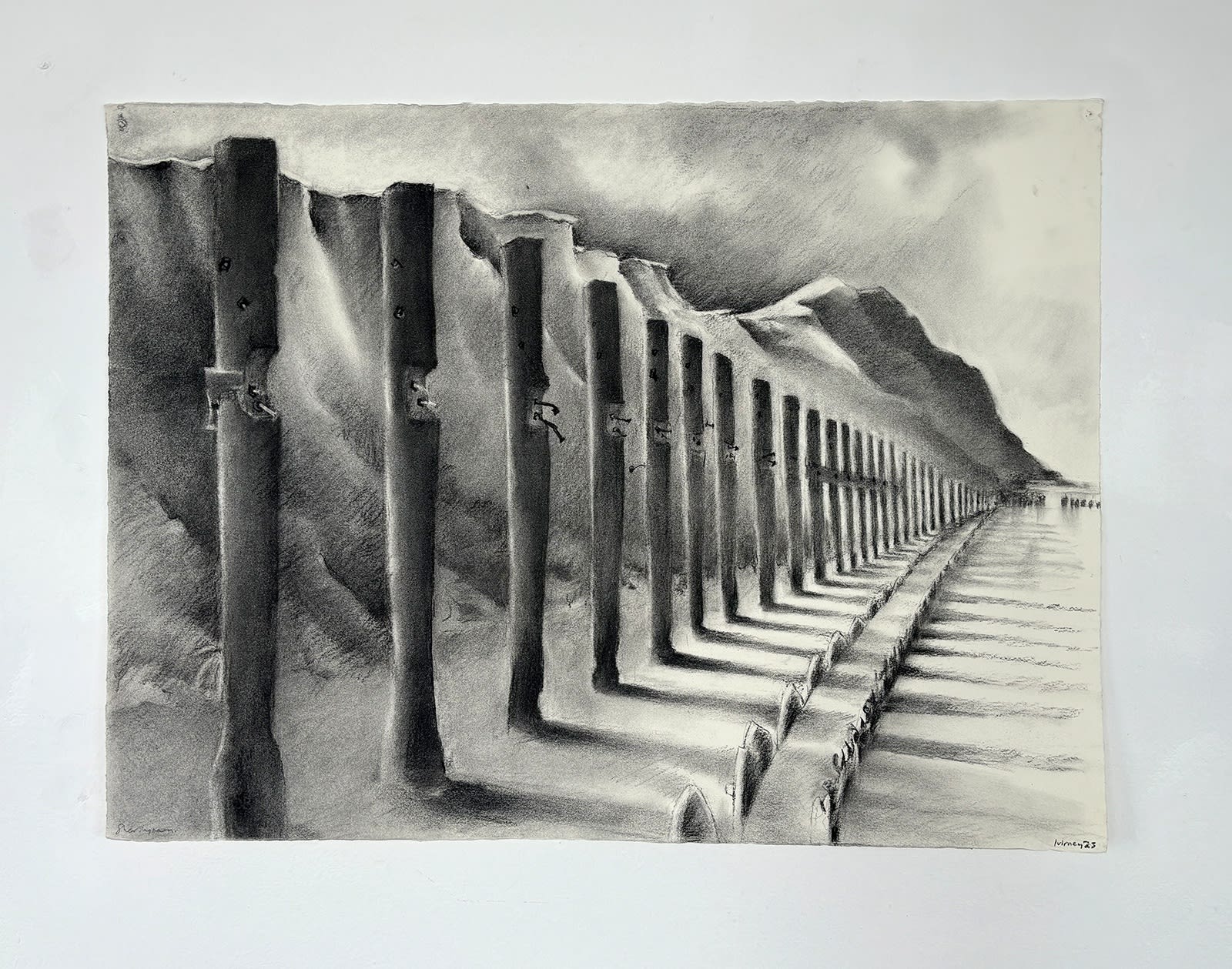
Jayne Ivimey and Andrew Watkinson installation 2024
After the pandemic and the isolation of the lockdowns, Jayne Ivimey and Andrew Watkinson decided to work on a project together, following in the footsteps of nineteenth-century landscape artist James Stark*. Stark accessed hard to reach places along the Norfolk coast between Sheringham and Lowestoft two hundred years ago, sketching what he found at each location. Jayne and Andrew combined their disciplines in art and science, to contrast Stark’s interpretive approach to landscape, with a scientific as well as a contemporary pictorial treatment of the coastal landscape in their survey of the coastline.

Andrew Watkinson and Jayne Ivimey at Cromer Artspace
Originally from Norwich, Jayne has been familiar with this coastline for most of her life. Sketching it since she was a child. James Stark is her great grandfather (X3). She has a strong connection with the landscape and Stark's historic representation of it.
Andrew Watkinson has worked at University of East Anglia (UEA) for many years as an environmental scientist. He is Emeritus Professor of Environmental Sciences and a Non-Executive Director of the Centre for Environment, Fisheries and Aquaculture Science, where he chairs the Science Advisory Committee. He has been one of the scientists based at UEA who have contributed to a long-term model that tracks the Norfolk coast's ongoing process of inundation, renewal and erosion.

Cromer Artspace, Cromer Promenade
Held between 11 and 22 July 2024, the exhibition was thoughtfully compiled, collating their research, clearly displayed within the Art Deco gallery space, tucked in under the cliff at the end of the Cromer Promenade. The gallery consists of a single room. It has three hanging walls, and one consisting of Crittal windows spaced between stout pillars, overlooking the beach at Cromer. The coastal site of the gallery provided a strong context to present their material, underlining the critical, research-led nature of the exhibition’s visual content, that questions the current approach to dealing with the implications of coastal erosion.

James Stark, Cromer - C.1837 print courtesy Norfolk Museum Service
Reproductions of Stark’s sketches were positioned on the walls either end of the gallery, bookending the long space, hung with geological samples, 'cliff scrapings' and Jayne’s disarming charcoal drawings of coastal erosion along the long back wall of the gallery. Accompanying notebooks, and pen and ink sketches were presented in vitrines and on tables. Jayne and Andrew’s thoughtful findings were interpreted in ways that made the case for a different approach to coastal erosion.


Jayne Ivimey, Coastal Defences, Mundesley (top)
and Happisburgh and Cart Gap 2023, Charcoal on paper
As if to underscore the purpose of the exhibition, the gallery looked out onto an imposing coastal defence renewal scheme, on Cromer beach. Earth movers were enacting a strange ballet, installing thousands of imported granite blocks, while holiday makers enjoyed the surf and beach!
Unfortunately schemes like these, installing barriers only slow down the inevitable progression of the sea in furthering erosion of the cliffs. Andrew Watkinson and his team at UEA have concluded that temporary barriers actually aggravate the process of beaches being washed away as sand is no longer replaced by the periodic collapse of sandy cliffs above, onto the beach surface, replenishing the material within the cycle of high and low tides.


Cromer beach coastal defence renewal July 2024
We will be showing a selection of Jayne Ivimey’s Camouflage drawings in our forthcoming exhibition of the work of 30+ East Anglian artists and makers – Lay of the Land at the Fermoy Gallery and Shakespeare barn in King’s Lynn opening 25 September.
* James Stark’s original paintings are available to view at the V&A Museum, the British Museum and Norwich Castle Museum and Art Gallery.
About the author

Paul Barratt
Paul Barratt started working in contemporary art galleries in 1989, having graduated in Fine Art from Goldmsith’s, London University. He initially worked at Anthony d’Offay Gallery, one of the contemporary art dealers, who dominated the London art market in the 80s and 90s. He was approached by the Lisson Gallery to be gallery manager for the influential art dealer Nicholas Logsdail. This was followed by a short period in New York at Gladstone Gallery, to work for visionary art dealer Barbara Gladstone, working with the artist and filmmaker Matthew Barney.
On his return to London, Paul secured a place on the postgraduate curatorial course at the Royal College of Art, to complete an MA. After graduation in 2001, he worked as an independent curator on several projects in Oslo, London, Brighton and Basel, before joining Paul Vater at his design agency Sugarfree in 2004. He has worked with Paul ever since.








